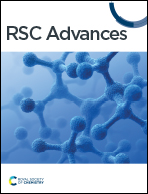Efficient dye adsorption of mesoporous activated carbon from bamboo parenchyma cells by phosphoric acid activation†
Abstract
In order to solve the environmental damage caused by the discharge of dyes as industrial wastewater, the development of efficient and sustainable adsorbents is the key, while most of the previous studies on bamboo parenchyma cells have focused on their microstructural, functional and mechanical properties, and few of the properties in adsorption have been investigated. To evaluate the role of the unique microstructure of bamboo parenchyma cells on adsorption after carbonization and activation, PC-based activated carbon (PPAC) was fabricated by the phosphoric acid activation method and tested for adsorption using methylene blue (MB). The effect of mesoporous structure on MB adsorption was investigated in detail using PPAC-30C impregnated with phosphoric acid at a concentration of 30%. The results showed that the adsorption performance was influenced by single-factor experiments (e.g., pH, activated carbon dosing). The adsorption isotherms and kinetics could conform to the Langmuir model (R2 = 0.983–0.994) and pseudo-second-order kinetic model (R2 = 0.822–0.991) respectively, and the maximum MB adsorption capacity of adsorbent was 576 mg g−1. The adsorption mechanism of MB on PPAC-30C includes physical adsorption, electrostatic attraction, hydrogen bonding, and the π–π conjugation effect, which was dominated by physical adsorption. The results of this study show that PPAC has good application prospects for cationic dye removal.



 Please wait while we load your content...
Please wait while we load your content...